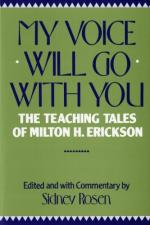
|
| Name: _________________________ | Period: ___________________ |
This test consists of 5 multiple choice questions, 5 short answer questions, and 10 short essay questions.
Multiple Choice Questions
1. Reframing often takes hold when the therapist or practitioner ties the facts with which of the following?
(a) Negatibe behavior.
(b) Fear.
(c) Reward.
(d) Punishment.
2. Through therapy Erickson believes that people are able to overcome a:
(a) Bad prognosis.
(b) Fear of flying.
(c) Childhood trauma.
(d) Bad habit.
3. How far did one patient throw a shot put before working with Erickson?
(a) 29'.
(b) 64'.
(c) 37'.
(d) 58'.
4. Sometimes people like to disagree just to:
(a) Be rude.
(b) Disagree.
(c) Prove a point.
(d) Make the other person mad.
5. The author states that there is a lot to be said for which kind of learning?
(a) Experiential.
(b) Theory-based.
(c) Socratic.
(d) Abstract.
Short Answer Questions
1. Erickson did encourage the man to do which of the following?
2. What is used as an example to support the above statement?
3. Erickson talks about patients overcoming which of the following:
4. It is important for a patient to learn how to combine possibilities with which of the following:
5. Erickson uses examples of people who are:
Short Essay Questions
1. How can a person learn from the behaviors and actions of children?
2. What did Erickson mean when he said that direct therapy may not always work? What can make it work?
3. Who is Victor Frankl? What makes his story an unusual one?
4. What was the example used regarding the fact that some people disagree just to disagree?
5. What is one tool that often helps the therapy along, even when the patient is resistant?
6. It is stated that there's a lot to be said for stubbornness. What is the example used regarding stubbornness and illness?
7. What is two main things were connected in the story about the athlete? How did the combination affect the athlete's performance?
8. What are the doctor's thoughts about experiential learning?
9. Discuss the last case in the book about the woman who ignored her children. How did Erickson help her?
10. Discuss one of Erickson's favorite therapeutic tools regarding everyday observations.
|
This section contains 807 words (approx. 3 pages at 300 words per page) |

|




